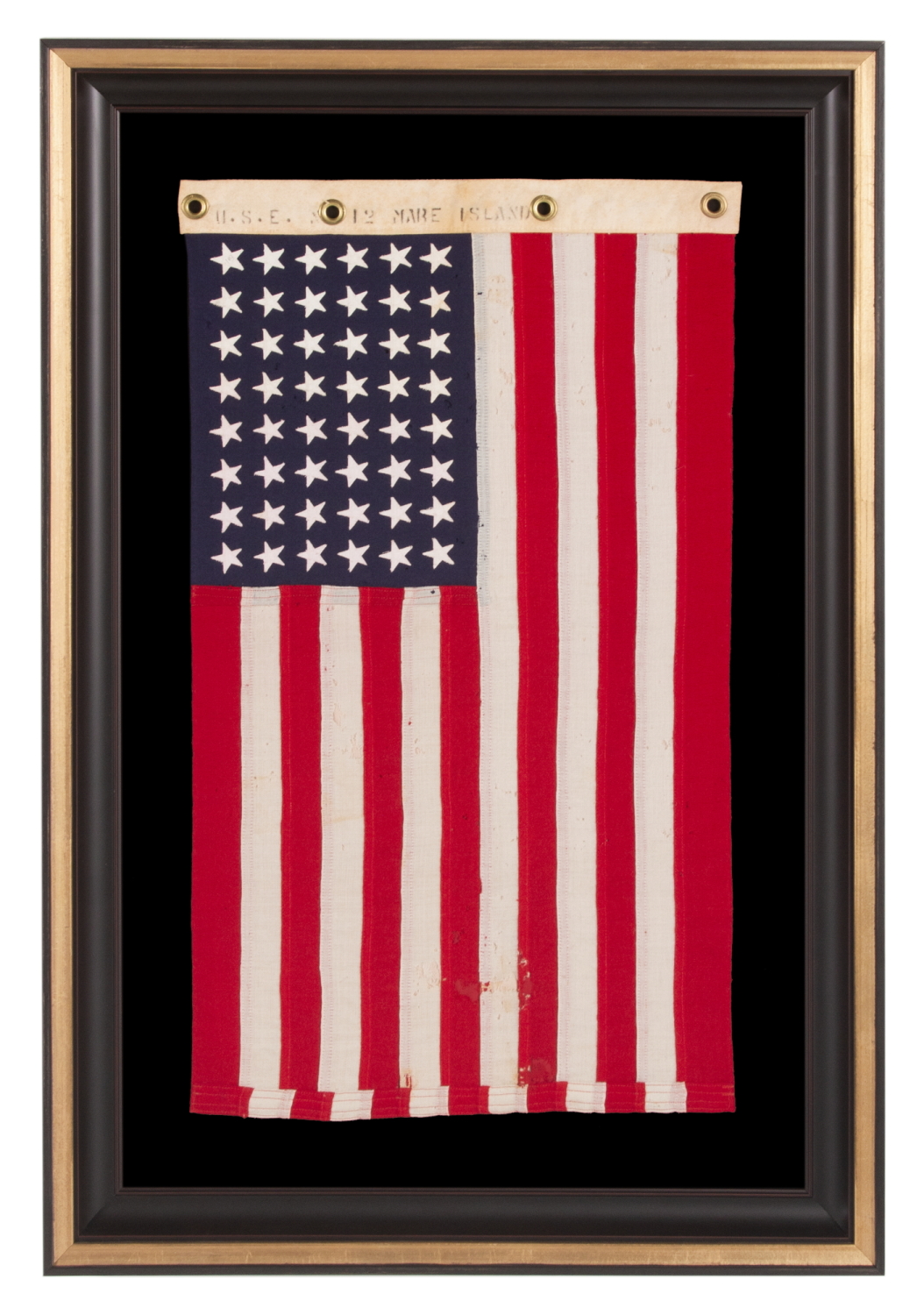
| |
ANTIQUE AMERICAN FLAG WITH 48 STARS, A U.S. NAVY SMALL BOAT ENSIGN, MADE AT MARE ISLAND, CALIFORNIA, HEADQUARTERS OF THE PACIFIC FLEET, WWI-WWII ERA (1917-1945) |
|
| Available: |
Sold |
| Frame Size (H x L): |
Approx. 41.5" x 28.5" |
| Flag Size (H x L): |
31.5" x 18.5" |
|
| Description....: |
|
48 star, U.S. Navy small boat ensign, made in the era between WWI (U.S. involvement 1917-1918) and WWII (U.S. involvement 1941-45) at Mare Island, California, Headquarters of the Pacific Fleet. A black stencil along the hoist on the reverse side reads as follows: "U.S.E. [ensign] No. 12 Mare Island”. While U.S. involvement in the Second World War (1941-45) necessitated the acquisition of flags from many sources flags, the Navy had long made their own flags at several locations, of which this was one.
Ensign is simply a term for the primary flag from a ship. "No. 12" is a size designation for a small boat flag that, per U.S. Navy Regulations of 1914, was to measure 2.37 x 4.5 feet.
The canton and stripes of the flag are made of wool bunting, of an unusually heavy weight, that has been pieced and sewn with machine stitching. The stars are made of cotton and are double-appliquéd (applied to both sides) with a zigzag machine stitch. There is a heavy canvas binding along the hoist, with four brass grommets. The general manner in which the flag is made, with higher grade fabrics and uncommonly stout construction, is indicative of U.S. Navy flags of the WWI-WWII era.
The 48 star flag became official in 1912 following the addition of New Mexico and Arizona. It remained the official flag throughout WWI (U.S. involvement 1917-18), WWII (U.S. involvement 1941-45), and the Korean War (1950-53), until Alaska gained statehood in 1959 and the 49th star was added.
Located on the western edge of the City of Vallejo, about 23 miles northeast of San Francisco, Mare Island (actually a peninsula) served as a principal seat of U.S. Navy defense, beginning in the mid-19th century. The site was originally chosen following an expedition that set forth in 1850, when Commodore John Drake Sloat was ordered to lead a survey party in quest of a logical site for the nation's first Pacific naval installation. Sloat recommended the island across the Napa River from the settlement of Vallejo; it being "free from ocean gales and from floods and freshets." On November 6th of that year, two months after California was admitted to statehood, President Fillmore reserved Mare Island for government use. The U.S. Navy Department acted favorably on Commodore Sloat's recommendations and Mare Island was purchased in July, 1852, for the sum of $83,410 for the use as a naval shipyard. Two years later, on September 16th of 1854, Mare Island became the first permanent U.S. naval installation on the West Coast, with Commodore David G. Farragut serving as Mare Island's first base commander.
The base became home to what was known as the Pacific Fleet, and remained so until the threat of Japanese expansionism caused the shift to a more advanced position at Pearl Harbor. It was very active in WWII, Korea, and Vietnam, but would eventually close in 1993 after Congress approved the findings of the Base Realignment and Closure Report.
Mounting: The flag was placed in its correct vertical position, with the canton in the upper left. The flag has been hand-stitched to 100% silk organza for support on every seam and throughout the star field. Fabrics of similar coloration were placed behind the flag during the mounting process. It was then hand-stitched to a background of 100% cotton, black in color, that was washed and treated for color fastness. The cove shaped molding has a very dark brown finish, almost black, with red undertones and highlights. To this a black-painted, hand-gilded and distressed Italian molding was added as a cap. The glazing is U.V. protective acrylic (Plexiglas).
Condition: There are areas of moderate mothing in the 3rd and 4th white stripes, toward the hoist end, accompanied by minor to modest mothing elsewhere throughout. There is modest soiling along the binding, particularly near the center. Many of my clients prefer early flags to show their age and history of use, especially when they present well, like this example. |
|
|
|
| Collector Level: |
Beginners and Holiday Gift Giving |
|
| Flag Type: |
Sewn flag |
|
| Star Count: |
48 |
|
| Earliest Date of Origin: |
1917 |
|
| Latest Date of Origin: |
1945 |
|
| State/Affiliation: |
California |
|
| War Association: |
WW 2 |
|
| Price: |
SOLD |
|
| |
Views: 1152 |
|
|
|

